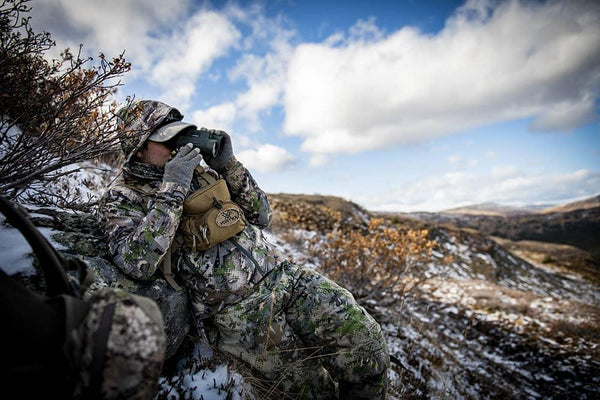How To Glass For Mule Deer - The Mule Deer Hunter
May 17, 2021
When rifle hunting the high country, it can seem very overwhelming at first. There is so much country that it can be overwhelming for some people to even figure out where to even start. Not only that, there is normally great amounts of hunting pressure in the high country which makes even finding a decent buck extremely difficult at times. While it can make for difficult hunting conditions, if you know how to glass for mule deer, you can swing the odds in your favor.
Mule deer do not wander aimlessly, therefore, neither do I. Every move they make is for a reason, whether it be to eat, drink, relieve themselves, or to simply survive. If they are up moving, rest assured, it is for good reason. I approach hunting in the same manner. If I am glassing a certain area at any particular time, there is a reason for it.Looking For The Best Camo For Mule Deer Hunting?
SKRE Gear® created the Mule Deer Bundle to facilitate success for trophy mule deer hunters in the harsh environments these animals call home.
Shop Mule Deer Clothing
Four Phase Glassing
If you are glassing aimlessly without purpose, you will not be making the most of your time.
Years ago, my glassing sessions had no structure and were very random, and as a result, were very unproductive. Throughout my 40 years of pursuing trophy mulies in the high country, my method has evolved based on what has worked and what hasn’t. It is an extremely simple, but yet highly effective and I refer to the method as Four Phase Glassing. I truly believe this method of glassing has been the number one contributor to my success.
My technique is basically divided into four different phases:
- Phase 1 – (initial glassing) is the rapid glassing of feeding areas. This technique is typically used during prime hours during morning and evening glassing sessions.
- Phase 2 – (secondary glassing) is slower paced than Phase 1 and is typically used to scan smaller openings near and among bedding areas.
- Phase 3 – (detailed glassing) is when you really need to start picking the mountainside apart, inch by inch. Typically this technique is used on terrain within rifle range. Most hunters have no problem with Phases 1 & 2, but lack the patience needed for detailed glassing. I will spend literally hour after hour picking the mountainside apart with my binoculars.
- Phase 4 – (ultra-glassing) is when you take Phase 3 to the next level. This is where you dissect the terrain with your spotting scope, rather than binoculars. Not only are you picking the mountainside apart, you are literally picking every tree, bush and shrub apart. It is basically the same as the previous phase, except you have a lot smaller field of view and you are able to further pick the hillside apart in greater detail. Phase 4 requires a lot of patience. Each glassing session can be several hours long, but if done correctly, I guarantee you will see more game than you ever have before.
Looking For The Best Camo For Mule Deer Hunting?
SKRE Gear® created the Mule Deer Bundle to facilitate success for trophy mule deer hunters in the harsh environments these animals call home.
Shop Mule Deer Clothing
Morning Session
When choosing your vantage point, be sure to pick one that offers views of as much terrain as possible. I like to choose one that allows me to see into multiple basins either from one location or within a short walk of additional basins. The goal for my morning glassing session is to remain relatively stationary at my vantage point and utilize my optics. At sunrise, bucks are either still feeding or heading to their bedding area which makes them more visible this time of day than any other time. This is without a doubt the best opportunity to locate a good buck so take full advantage of it.
Prep Your Vantage Point
Once at my vantage point, before I even begin glassing, I setup my spotting scope on a tripod so that when I locate a buck while glassing with my binoculars, I can zoom in and take a better look immediately. If you don’t set up your scope prior to glassing, there is a chance you may not get a good look prior to the buck disappearing. Trust me, there is nothing worse than having a buck disappear and not knowing whether he is a shooter or not. Not only will it drive you nuts not knowing, but you may end up wasting additional time trying to relocate the buck again, only to possibly find out he is not a shooter.
Phase 1
Once I sit down and get comfortable, I conduct my initial glassing of the area using the Phase 1 glassing technique, which has one purpose, and that is to locate any obvious deer that may be out in the open in feeding areas. This initial glassing is done at a fairly rapid pace covering all of the terrain in sight, especially the larger openings. The main reason I concentrate on the large openings first is because the deer have been up feeding in the predawn darkness and I am hoping to find any stragglers still out feeding in these openings. Don’t worry about picking the mountain apart at this stage, your main goal at this time is to cover a lot of country in a short amount of time.
I prefer to glass the closer areas first. This allows me to glass any bucks that might already have me spotted and I can get a look at them before they are gone. Odds are, the deer that are a long way off, have no idea that I am even there. Once you have glassed the immediate area, start glassing the distant terrain.
Once I spot a deer, I make sure to immediately take a closer look through the spotting scope prior to continuing glassing. During the prime glassing hours in the morning bucks are constantly moving, often times at a very fast pace, and can vanish from sight if you wait too long. After I have glassed all of the surrounding terrain several times and feel confident I have covered the feeding areas thoroughly, I move onto glassing possible bedding locations and immediate areas surrounding them.
Phase 2
When glassing these bedding areas, I use my Phase 2 technique. This phase differs from the first, in that I will glass at a much slower rate and concentrate more on the smaller openings near and inside prospective bedding areas. I like to divide the mountain into sections, using things such as small finger ridges that run from the top of the mountain down to the bottom as the dividers. Then I concentrate on one section at a time to make sure I cover all of it effectively. I will glass each section thoroughly before moving on to the next section. If the section looks real bucky to me, I may glass it several times before glassing the next section. I will continue this pattern until I have glassed the entire hillside. I will then begin glassing another hillside. Once I have completed Phase 2 glassing on all hillsides, I will then go back to the first hillside and repeat this process over and over. Sometimes I will do this for hours depending on temperatures and the amount of deer I am seeing.
During my Phase 2 glassing, I make mental notes of anything that could possibly be a deer. I am not necessarily looking at every deer through the spotting scope at this time, because I have already looked the majority of them over during the first phase. In addition, deer are not moving as fast as they were when in their feeding areas. As you glass the country over and over, you will get to the point that you will have the mountainside memorized and it will be fairly easy to detect any new deer that may appear. I will normally continue glassing using Phase 2 glassing until all deer have bedded. Typically, this is around 9:00 a.m. but varies based on time of year and weather conditions.
Mid-Day Session
Most people will call it quits on glassing after their morning session, but I like to glass all day long. Exactly how to glass for mule deer mid-day depends on the terrain I am hunting and whether I am hunting alpine basins or lower secondary ridges.When hunting alpine basins, after glassing from my morning vantage point, I will hike a short distance down the ridge which brings new country into view and will start glassing again. This glassing differs from the morning glassing session where I was concentrating more on wide open basins and avalanche chutes, now I am focused on the timber trying to locate bucks in their beds using the Phase 3 glassing technique.
Phase 3
During this time, I am concentrating on close areas and normally glass everything within rifle range. I’m not looking for an outline of a deer anymore, now I’m looking for the tips of antlers, the tip of an ear or any slight movement that could be a buck tucked away in the shadows. The key word here is shadows. I don’t waste any time glassing the areas that are in direct sunlight, I’m concentrating all of my efforts glassing any available shade. The areas I am focusing on are the scrub pines located in the bottom of the basins, any finger ridges within the basins and the secondary ridges on either side of the basins. I will pick apart all of the shadows for about an hour and then relocate and repeat this process all day long until my evening glassing session. Trust me, you will be amazed at how many deer you can see during the day glassing this way.Phase 4
If I know there is a big buck in a basin, I will utilize the Phase 4 glassing technique almost all day long. First, I will begin on one side of the basin and will glass the entire basin with my spotting scope until I feel satisfied I have covered everything.Then I will move a short distance along the head of the basin and will stop and glass again. I will repeat this process all the way along the top of the basin until I have glassed it from every possible angle.
Evening Session
Typically, I like to be back on a good vantage point and ready to glass for my evening session by 3:00 pm. At the beginning of the session I will focus on bedding areas near the upper third of the hillside using the Phase 2 glassing technique. It is critical that you focus on the bedding areas at this point and not the larger openings. As the sun lowers and you are starting to see bucks show up in the larger openings, it is time to switch back to Phase 1 glassing where you will try to cover all of the open areas at a fairly rapid pace. This session is essentially conducted the exact opposite of your morning session.
Long Range
A common mistake I see hunters make is they focus on glassing up close terrain and totally forget about glassing distant mountains. Long range glassing is most effective during your morning and evening glassing sessions. I typically will not use this method during the heat of the day because heat waves are too bad and the deer are not utilizing the open feeding areas during this time. I normally glass all mountainsides within sight. It doesn’t matter how many miles away they are. Under the right conditions, you will be amazed at how easy it is to spot bucks miles away in the distance. At times, you can’t necessarily see much detail at these extreme distances, but you can normally tell whether a buck is worth a closer look or not.
Use a Spotting Scope
When I am glassing at extreme distances, I often use my spotting scope. I am glassing well beyond the limits of my 8 power binoculars. While I use a spotting scope, there are a lot of people who choose to use binoculars in the 15-20 power range. The reason I choose not to use 15-20 power binoculars are because of their size.How to Glass For Mule Deer in Hot Weather
Hunting trophy mule deer can be extremely tough even under the best of conditions, much less when it is unseasonably hot. Unfortunately, during archery season or early season high country rifle hunts, hot weather is usually the norm. During these early hunts, the success rates are very low and hunters don’t see much game. One of the biggest complaints I hear hunters have is there just isn’t enough glassing time in the mornings and evenings before mule deer bed down for the day when the weather is hot. It is extremely important during these tough times that you maintain a positive attitude and use proper glassing technique.
Your window of opportunity to glass during the prime hours is definitely short because the temperature rises so quickly this time of year. I have literally watched bucks stay just ahead of the sun as it rises and starts to illuminate the hillside. The bucks will disappear into the trees before being touched by the sun. Normally in this type of heat, most bucks are bedded by 7:30 a.m. You will have a few stragglers out feeding until 8:00 a.m., but even then, that’s not much time.

Glass Against The Grain
Glassing the traditional way, with the sun to your back, really limits the amount of game you will see. This definitely works as far as lighting up the hillside is concerned, but unfortunately, an illuminated hillside doesn’t do you much good when there is no game utilizing it. I do just the opposite and glass towards the sun, or at least at a ninety degree angle to it. I call it glassing against the grain. What this means is you will be glassing the west-facing slopes in the morning, and the east-facing slopes in the afternoon.
In the morning, I will first glass the east slopes very quickly, but once the sun hits them, I will spend the rest of the morning glassing the west slopes until everything beds down for the day. If the terrain is extremely rugged, the sun won’t hit these slopes until late morning, giving you a considerable amount of glassing time. In the morning, bucks will remain up feeding on the west-facing slopes for at least an hour longer than the bucks on the east-facing slopes.
When I start glassing in the evening I will do just the opposite. I will start as soon as shadows start to appear on the east-facing slopes, which is normally about 3:00 in the afternoon. Bucks will get up to feed on the east-facing slopes an hour or two before the bucks on the west-facing slopes. I will not glass the west-facing slopes until the sun has set, then I will spend the remaining half hour of daylight glassing the illuminated west-facing slopes.
How to Glass for Mule Deer in the Rain
Don’t be that guy that hunkers down in his tent every time it begins raining. This is an extremely productive time to be glassing and is definitely one of my favorite times to be scanning the country for big bucks. The cooler temperatures associated with the rain prompts bucks to get up and get in some feeding regardless of the time of day. The bucks won’t be out in the large openings where they typically feed in the mornings and evenings, instead, they will stay close, or even remain within their bedding areas. Focus all of your attention on the small openings within prospective bedding areas or on the slightly larger openings immediately surround the bedding areas.
I used this exact method in 2004 while hunting western Wyoming to kill the largest buck I have ever killed. It was approximately 9:00 am which meant on a normal day my morning glassing session would pretty much be over, but on this particular day, it was overcast with a slight drizzle. The temperatures were a bit cooler so I decided to remain at my vantage point and pick apart the small openings in hopes of finding a good buck up catching a bite to eat.
Remain in the field all day when it is raining and put your optics to good use picking apart the small openings within bedding areas. You just might take the buck of a lifetime.
Make sure you aren't caught in the rain unprepared! Purchase your SKRE Nebo Rain Jacket and SKRE Nebo Rain Pant before your next hunt.

Check out all the posts in the series Modern Day Trophy Mule Deer Hunter:
Part 1: Mule Deer Tips and Tricks
Part 2: Mule Deer Scouting Tips
Part 3: How To Glass For Mule Deer
Part 4: Mule Deer Habits and Behavior
Part 5: Where Do Mule Deer Live
Part 6: Mule Deer Hunting Gear
Part 7: Hunting Fitness
Part 8: True Grit



